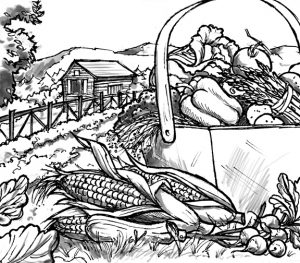Time to Plant Greens for Fall and Winter
by Peter Heffelfinger
August in the Pacific Northwest offers the best weather of the year, reasonably cool yet sunny and dry. Rain is a distant memory, for now. Other regions have sticky humidity and drenching thunderstorms, face the threat of tornadoes and flash floods, or endure searing desert heat and drought. For local gardeners the most serious concern is sufficient watering during our short Mediterranean dry cycle as well as keeping up with the bountiful harvest. Potatoes are ready to be dug up; large cabbages are splitting their outer leaves; corn is ready, beans are ripe, and tomatoes are getting sweet. Preserving these crops at the height of summer can take up all one’s time, whether by canning, freezing, drying, or setting up in-house storage areas.
Thanks to our moderate climate August is also a second major planting time for a wide range of both tender and hardy greens that do not do well in summer heat. Amidst all the harvesting of the main crops, it is wise to make sure your garden continues to offer fresh salad produce into the cool season that is coming all too soon. The basic long season crops that were planted earlier are sizing up: kale, Brussels sprouts, leeks, late cauliflower and broccoli, as well as root crops for storage such as carrots, celeriac, beets, and parsnips. They will continue maturing for either harvest in the fall or staying in the ground during the winter. For a wide assortment of garden greens, however, it is time to restart the cycle of crops that will do better as the days get shorter and the nights get cooler.
Restarting the Cycle
Cilantro will last longer with less daylight hours, not going to seed too soon, as happens in the spring and summer. Green onions are a welcome addition to salads and salsas, whether regular scallions or the more hardy Japanese types that will stand up to cold winter temperatures. Lettuces also do better, not getting bitter so rapidly, particularly the romaine types, such as Winter Density, a compact type. Most lettuces, even the tender butter head and leaf types will also do quite well given a floating row cover once the temperatures start to drop. The gourmet greens such as chicory, endive, and escarole are a lovely addition to one’s salad palate, adding a touch of bitterness, much like the hearty winter ales full of hops.
A traditional fall planting is spinach, particularly Winter Bloomsdale, which will stand up to snow and be ready to go to seed in the spring. Chard of any kind can also be sown; it may die down in severe cold and wind, but will sprout up again in the spring if the root system is well developed. My favorite fall and winter green is Broccoli Raab, a cut and
come again variety that will survive under cover well into winter. Another option is peppergrass, a garden cress that is a snappy addition to a salad, along with a second planting of quick growing radishes. Larger, slower developing radishes include both the Oriental daikon types, as well as the dense Black Spanish radishes. In addition there are small bulb turnips grown only for the greens, to complement the hardy collards that would have had to be planted much earlier. Note: in spite of their association with the South, collards are very cold hardy up here in the moderate, maritime North.
Zesty Greens
Later towards the end of August, put in arugula for another zesty salad addition, along with mustards, both the red or green large leaf type, as well as the smaller Oriental Mizuna. The low-growing Tah Tsai oriental green is exceptionally hardy as well. For durable European greens, seek out corn salad (also known as mache), Miner’s lettuce, or Italian dandelion, for a salad mix that will brighten up a dreary day. Looking ahead to September, leave room for a fall crop of snow peas, a favorite addition to stir-fries, or just enjoyed fresh off the vine.
Once the late summer and early fall plantings are in, you can look forward to a continual extended harvest that will be fresh, varied and homegrown. During the dark days of winter it is deeply satisfying to graze for fresh greens in the mostly dormant garden, in spite of the wind and rain. You can also thank yourself for taking the time to plant in the heat and light of August.
____________________________________
Peter Heffelfinger, a Washington State University master gardener, has gardened organically on Fidalgo Island and the Skagit Flats for over 40 years. He has given workshops in year-round gardening for Transition Fidalgo/Eat Your Yard, Christianson’s Nursery, and at the Washington State University County Extension Service. He is a Salish Sea Steward, working on the invasive green crab survey.


